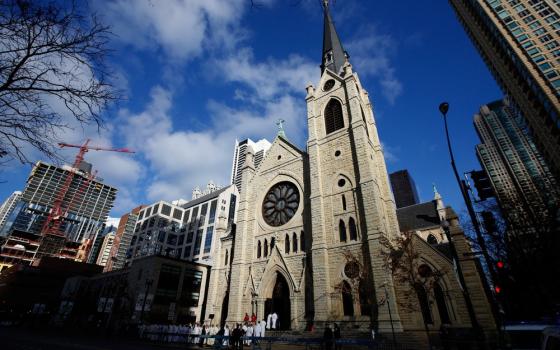
Rome
Using both symbols and words, some 800 women religious from around the world sat down together here to begin exploring links between mysticism and prophecy with the aim of energizing the lives of the communities.
Sister of Notre Dame de Sion Maureen Cusick, incumbent president of the International Union of Superiors General, presented the theme chosen for this year’s gathering: “I know the fountain well which flows and runs…though it is night.”
In her opening remarks she told the women the purpose of the conference was to be open to the Spirit, not come together to write a statement. But she added: “if we are really listening, in a mystical and contemplative mode, then we must speak out as prophets to the church and the world.” This, she said, could lead, in fact, to some kind of public statement.
She called the gathering an “adventure in obedience,” explaining the women need to hear the word of God and then act on that word.
The ‘word’, she continued, comes in many forms, not just from the Biblical text. “We hear God’s word spoken to us through the events of our day and through many situations, books, lectures…”
“Our consecrated obedience calls us to be open to the word from wherever it comes, to interpret and to speak this word to others. We are here in this big event to listen together to God’s word. 800 pairs of ears and hearts.”
The theme of mysticism and prophecy was chosen following suggestions from religious superiors. According to conference organizers, the twin theme was the resounding choice of the women. Cusick said the “the strength of your voices” in favor of the theme led organizers to believe the women are being “called again to seriously renew our commitment to the mystical aspect of our lives in order to renew also the prophetic dimension of our lives.”
“We cannot speak a prophetic Word,” she said, “if we are not mystics in our relationship with God.”
Following her talk the women sat around tables to share with each other small objects they brought with them to the conference, objects that speak to each in an especially spiritual and mystical way. Some brought art works, other religious prayer objects; others lit candles and spoke about their prayer lives. Each, in turn, explained how the symbols they brought with them had touched their lives and had lead them to the Spirit.
Spanish Carmelite Father Ciro Garcia also addressed the need to focus on mysticism and prophesy, citing the writings of St. John of the Cross. Garcia went further, saying “there is no future for religious life without mysticism and prophecy.”
He said that all the founders and founderesses of religious orders were both mystics and prophets. “We are called to recreate their mystical-prophetic charism in the Church.”
“Mysticism and prophecy are two essential, closely connected dimensions of every religious identity, of Christian life and of consecrated life. The first is more directly projected towards union with God, the second is more immediately oriented to the fulfillment of his will here and now.
 “Only a wise combination of both of them will forge an authentic religious identity of God and of the human person,” Garcia said. “There is no authentic mysticism if it does not flow out of an ethical and prophetic commitment, nor is it possible to think of a prophecy which is not nourished by a deep union with the divine.”
“Only a wise combination of both of them will forge an authentic religious identity of God and of the human person,” Garcia said. “There is no authentic mysticism if it does not flow out of an ethical and prophetic commitment, nor is it possible to think of a prophecy which is not nourished by a deep union with the divine.”
Said the Carmelite: “Just as mystical life is characterized by the experience of the overwhelming presence of the ‘Other,’ prophetic life is characterized by listening to the Word that comes from the divine and which the prophet feels constrained to transmit, often against his will.”
"In effect, Christianity is originally a mysticism, not ethics or a moral code; it is the mysticism of following Christ and baptismal conformation to Him. In the same way, consecrated life is mysticism and prophecy; it is essentially consecration to Christ (mysticism) and proclamation of the Good News (prophecy)."
Fox is NCR Editor and can be reached at tfox@ncronline.org.




